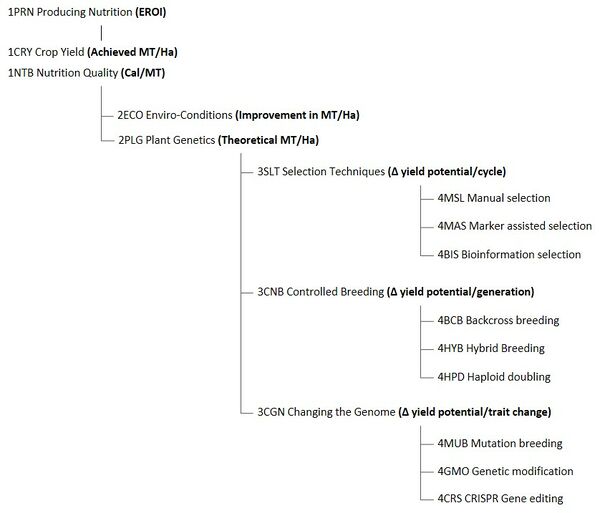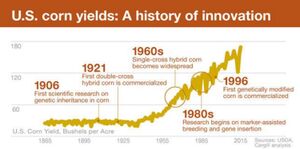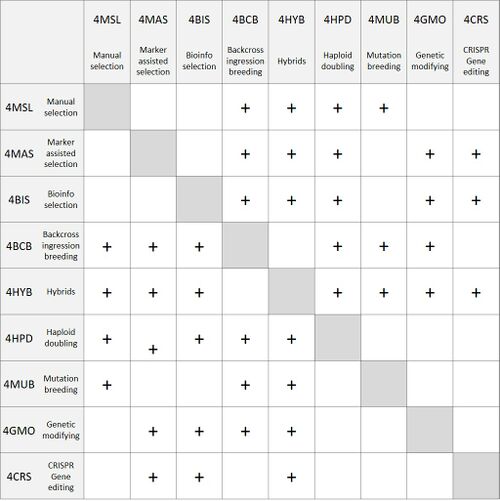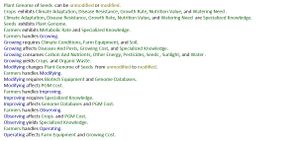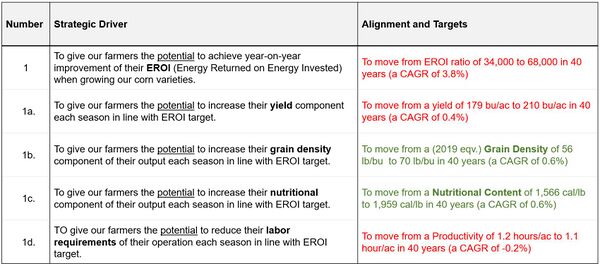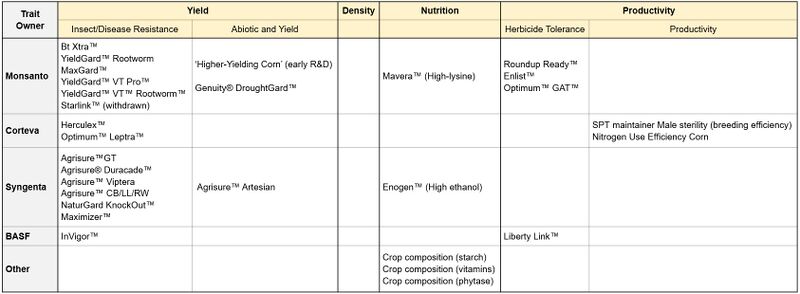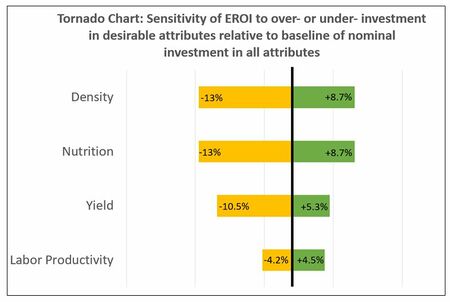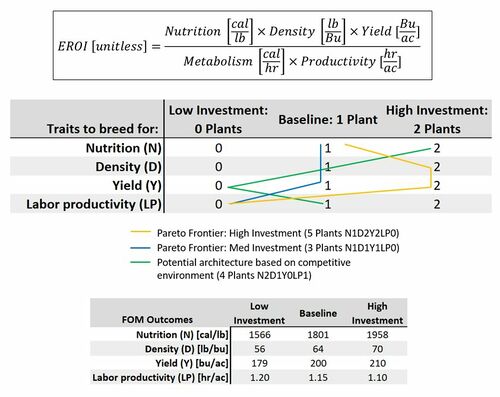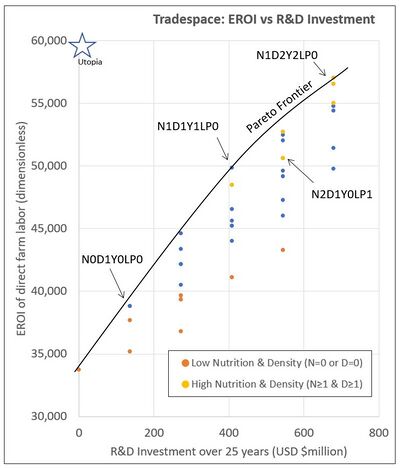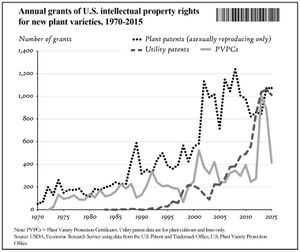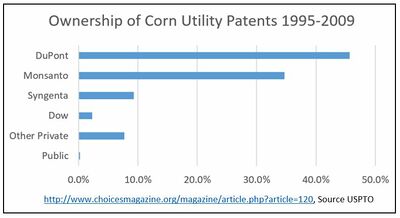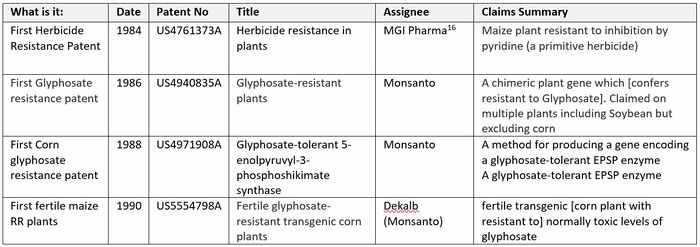Difference between revisions of "Plant Genetic Improvement"
| Line 137: | Line 137: | ||
[[File:BreedingSensitivities.JPG| | [[File:BreedingSensitivities.JPG|1000px]] | ||
==Key Publications, Presentations and Patents== | ==Key Publications, Presentations and Patents== | ||
Revision as of 03:47, 12 November 2019
Technology Roadmap Sections and Deliverables
The goal of Plant Genetics Improvement is usually to achieve better outcomes in crop production in the form of more Useful Crop Yield. These improved outcomes can be either increased yield, better quality or improved tolerance. The science of Plant Genetic Improvement has traditionally been the domain of the plant breeder. The technology used for Plant Genetic Improvement consists of both tools and methods as shown below:
Our roadmap is focused on the technologies which contribute to improving 2PLG Plant Genetics and the key Figure of Merit (FOM) is Theoretical MT/Ha.
Roadmap Overview
Plant Breeders contribute to increasing Useful Crop Yield (1CRY) and they do this through the science of improving Plant Genetics (2PLG).
Plant Breeders control a genepool in distinct phases - firstly variation - allowing or encouraging wide variability in the genotype, secondly selection of plants with desirable phenotypes (characteristics). Finally plant breeders then aim to eliminate variability from the gene line of the selected plan, in order to produce a consistent gene line for crop production
In summary, plant breeding is based on these key phases: Create variation → Selection → Eliminate variation and the plant breeder achieves this through the major technologies (both tools and methods, with discovery year in brackets) as follows:
- Selection Techniques (3SLT)
- Manual selection (4MLS) a traditional approach which has been carried out for thousands of years.
- Marker assisted selection (4MAS) – a genetic technique where a genetic marker is placed in the genome next to a desirable genetic characteristic which allows desirable plants to be selected before the trait is exhibited in the phenotype. (1986)
- Bioinformatic selection (4DSB) – a bioformatic technique to identify favorable characteristics from the sequenced genetic information of a plant. (2008)
- Controlled Breeding (3CNB)
- Backcross introgression breeding (4BIB) – a breeding technique to move a desirable characteristic from one plant to another line of plants. (1922)
- Hybridization (4HYB) – A natural phenomena where the offspring of purebred parent lines are more healthier than their parents, but themselves sterile. (1926)
- Haploid doubling (4HPD) – a laboratory technique which can create stable parent lines through a laboratory process, rather than seven field seasons of inbreeding. (1959)
- Changing the Genome (3CGN)
- Mutation breeding (4MUB) – a breeding technique which uses primitive methods to force variation in a plant population – for example using exposure to radiation. (1930s)
- Genetic modification (4GMO) – genetic engineering techniques to introduce non-host species genetics into a plant from say a bacteria or different plant species. (1982)
- CRISPR Gene editing (4CRS) – latest genetic technique to be able to cut and paste gene sequences between plants in the laboratory. (2012)
Design Structure Matrix (DSM) Allocation
The DSM is used to show the interaction between tools and methods which make up Plant Genetic Improvement. The + sign indicates that the techniques are compatible and can be used together.
Roadmap Model using OPM
We provide an Object-Process-Diagram (OPD) of the Plant Genetic Improvement roadmap in the figure below. This diagram captures the landscape in which Plant Genetic Improvement belongs and the interfacing systems with which it fits.
An Object-Process-Language (OPL) description of the roadmap scope is auto-generated and shown on the right. It reflects the same content as the previous figure, but in a formal natural language.
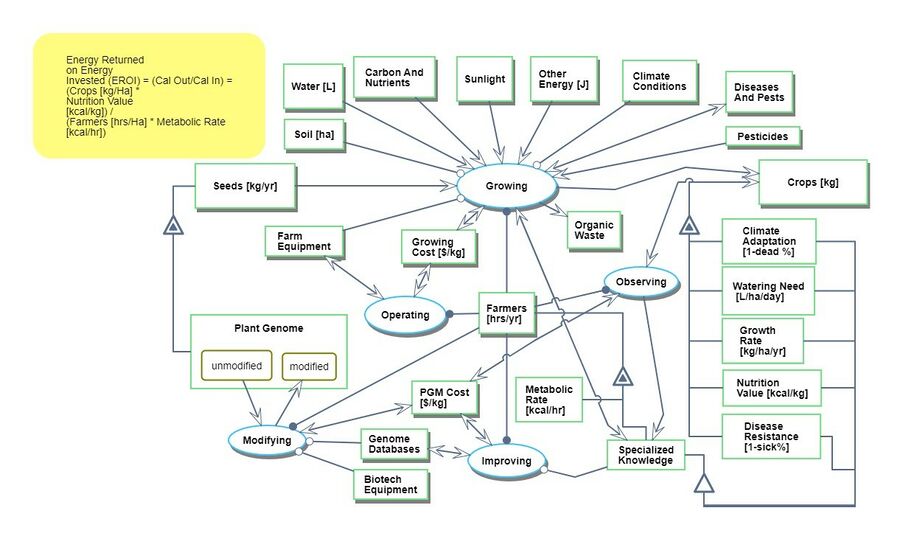
Figures of Merit
The table below show a list of FOMs by which plant genetic improvements can be assessed.
Alignment with Company Strategic Drivers
Our company has a vision to provide farmers with seeds which enable them to continually improve their Energy Returned on Energy Invested, and the roadmap relates to technologies which enable this vision.
Of course, there are other growing factors (both inside or outside of the farmers control) which impact Energy Returned on Energy Invested - these other factors are shown on the Roadmap Tree as '2ECO Enviro Conditions'. Therefore, our company can only provide to the farmer the genetic potential to achieve improvement.
In our Plant Genetic Improvement business, we manage a small portfolio of varieties, and an R&D pipeline of new varieties. This is similar to how the pharmaceutical industry manages a pipeline of drugs. Each year our R&D pipeline produces several new varieties with incremental improvements on previous varieties. For this reason, our targets for each driver are shown in terms of a small, statistically-proven percentage improvement over previous varieties.
Positioning of Company vs. Competition
The table below summarizes all the GM traits registered for use in corn in the US. The left-most column shows the owner-company which owns the trait and which is also likely the discoverer. This owner-company can and will be licencing these traits to the other seed companies shown here, and many other small seed companies across the US.
The trait competitive landscape table shows the environment which we face as a small biotechnology start-up which is trying to find a position in the corn trait market. Of course, trait development programs can take 20 years to bring to market (hopefully less with new technology). We must compare the table above, against our company goal which is ‘giving farmers the potential to improve their Energy Returned on Energy Invested (EROI)’ and the drivers of this which are: yield, nutritional content, density and productivity.
- Yield – there are many traits which are designed to ‘protect’ yield from insect and disease damage, and abiotic stress. There is only one trait (in early development) which is actually targeting the genetic source of increased yield. Regardless, this is a crowded space and likely not an opportunity.
- Density – No traits on market or in development to improve the volumetric density of corn. This could be a potential target for our company. Our 16.887 team has conducted interviews with corn breeders in the last few days who suggest that this could be a commercially viable trait, and an achievable R&D objective.
- Nutrition – There are several nutritional traits in development or on market, but only one focused on calorific energy (starch) – this trait is in early R&D at a university in Spain. In corn, the calorific energy is stored in the form of carbohydrates as both starch and sugars. There is opportunity for our company to pursue increasing the calorific energy of corn as an R&D objective.
- Productivity – There are many productivity traits including the most successful – RoundupReady herbicide tolerance. Productivity traits are a more challenging target for a small independent biotech company – very often productivity traits involve cross-discipline technology partnerships (for example RoundupReady is a cross-discipline technology involving genetics and agro-chemicals).
In summary, the competitive chart suggests that our initial R&D efforts should focus on understanding the plant physiological pathways which are responsible for grain density, as well as increasing the calorific value of the grain.
Technical Model
As metabolic rate can be considered constant for a human farm worker, the other four parameters, Nutrition (N), Density (D), Yield (Y) and Labor Productivity (LP) are targeted for improvement via the technology of Plant Genetic Modification. From the tornado chart, we note that density and nutrition are the two parameters that EROI is most sensitive to, followed by yield and labor productivity.
The tradeoff is the time and cost it takes to develop, obtain approval for and roll out a new trait. Based on our literature review, we found that investment in a new genetically modified plant is a long process which takes ~20 years to complete with a total cost of $136m[1]. For our fictional company, we set a budget of $700m in R&D spending (I.e. up to 5 plants at the cost of $136m per plant), and generated a number of feasible architectures with investment in 0-5 plants where each plant targets Nutrition, Density, Yield or Labor Productivity.
The morphological matrix summarizes project architectural decisions of how many plants with which traits to commit to developing over the next 25 years. Choices are low investment (0 plants), baseline (1 plant), or high investment (2 plants). The projected achieved FOM per investment is shown in the FOM outcomes chart.
The resulting architectures are plotted in a tradespace of cost vs. EROI, always with respect to the energy invested by direct farm labor. The architecture labels indicate the number of plants invested per targeted trait (for example, N1D1Y1P0 is 1 plant targeting nutrition, 1 plant targeting density, 1 plant targeting yield, and 0 plants targeting productivity).
Financial Model
Plant breeding is a financially challenging endevour because of the long timeframes involved, typically 10 years to develop a new variety, and therefore Net Present Value financial analysis which takes into account the time-value of money is especially applicable. This section will consider how a small plant breeding company would use NPV to decide how to make technology investments.
Firstly, we have to understand the activity which a plant breeding company will be undertaking. Plant breeding is about improve a population of plants in terms of a key characteristic such as yield. The plant breeder starts with a first generation of plants and selecting the best ones (those exhibiting the high yielding characteristics) to take forward to the following generations. By selecting from each subsequent generation, the overall yield characteristic of the population can be improved. The Rate of Genetic Improvement in plant breeding is measured by a very well-known governing equation known as the ‘Breeders Equation’:
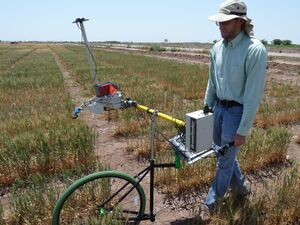
The new technological innovations in plant breeding will all contribute to improving these underlying drivers of plant breeding; some of these technical improvements are shown below as examples:
- Driver: Cycle Speed – how fast a selection cycle can be made. The baseline is one selection per year.
- Shuttle breeding (1960s) where genetic lines are shipped around the world to take advantage of three climates in a year (x3 gain)
- Speed Breeding (2000s) uses protocols such as artificial light and temperature to rapidly express phenotype characteristics (x1.5 gains)
- Driver: Selection Intensity – increasing the superiority of the selected parents over the population mean, which is achieved by increasing the population sizes for the same resource spent:
- Phenocart is a low-cost, hand-pushed phenotyping device with multispectral sensors and used to quickly phenotype breeding plots (+7% gain over manual methods)
- Rapid phenotyping using remote sensing and computer vision to increase the populations size (+25-75% faster data collection with drones)
- Driver: Selection Accuracy – are the correct gene lines being carried forward to the next cycle.
- Marker assisted selection (1980s) is using introduced or natural patterns in the genome to identify which candidates will exhibit the desired phenotype. (up to +50% gain in accuracy)
- Use of genomic data selection methods to improve accuracy is increasing. A recent paper details how by using high-throughput measurements of plant temperature and light reflectance combined with genomic information, predictions of yield achieved accuracy over traditional selection (+7% over standard genomic selection models)
The small plant breeding company will have to decide how to invest in the above technology, and can use Net Present Value methodology and the Breeders Equation to decide where to spend its technology budget. Each dollar spent on technology will have an impact on the Breeders equation, and ultimately lead to higher returns when the seed variety is commercialized. In order to understand the returns from investing in each driver over a ten year breeding program, a small quantitative model of a seed breeding pipeline has been built. This makes the following assumptions: Assumptions
- Starting Population = 100 Breeding Stations
- Max Breeding Stations = 1,000
- Each selection produces 20 progeny
- h2 heritability = 50% (so σ and μ vary by 50% each generation)
- St Dev of yield of child generation is 1.5x parent generation population
Key Publications, Presentations and Patents
As shown in the charts below, the number of agricultural biotechnology patents has increased significantly in the last 20 years, and a few large corporations hold the majority of the corn utility patents in the US. As of 2009, Dupont, Monsanto, and Syngenta, and Dow held over 90% of all the corn utility patents. In 2015, Dow and Dupont merged into Dow-Dupont, further reducing the distribution of patent ownership.
Compared to other technologies, the patents that are granted for genetically modified (GM) plants give inventors a wide scope of authority. The patents granted cover not only the plant itself but also strongly influence any subsequent technologies and research based off the original invention. This is mainly driven by US patent policy that grants both plant patents and utility patents. For example:
- the plant patent protects against others duplicating the plant breed, selling the plant, or importing the plant from outside the US
- the utility patent protects the plant itself and its descendants, while also covering the method of production and the uses of the plant
The patents around corn genetic modification are complex as protection is spread across multiple patents – sometimes the gene is patented, or a method to make it or insert it or the location on the chromosome. However, the table below shows what we consider to be some of the key patents from the early period of glyphosate-resistance genetic modification in the 1980s.
The table below shows what we consider to be some of the key publications related to breeding corn for improved yields, improved density, improved nutritional content, or improved productivity.
Terminology
- Variety is a specific genetic line which has been improved by plant breeders and genetically stabilized for commercialization. A variety will belong to a seed company and any one variety will have a lifetime between a couple of years and a decade. An example variety is P9492AM which is a Pioneer seed variety in Pioneers hybrid family P9492.
- Genetic Modification is a technique of editing the genome of a plant in a way which couldn’t be achieved by conventional breeding. Often using genetic code from a different species.
- Trait is the term given to describe a specific phenotypical feature (usually beneficial) which is expressed by the organism. For example, blue eyes is a trait in humans, whilst glyphosate herbicide resistance is a trait in a corn plant.
- Trait Brand is typically a trademarked name given (for branding and convienience) to a trait which has been discovered, commercialized and protected by a biotech company (eg. RoundupReady). The brand will be familiar to farmers, and has a lifetime measured in decades, depending on how long the trait remains competitive.
- Event is a term to describe the insertion of a particular transgene into a specific location on a plant chromosome – an event leads to the plant exhibiting the trait.
References
[1] McDougall P. The cost and time involved in the discovery, development and authorisation of a new plant biotechnology derived trait (2011). https://croplife.org/wp-content/uploads/2014/04/Getting-a-Biotech-Crop-to-Market-Phillips-McDougall-Study.pdf
Hickey et all 2019
Crain, J.; Mondal, S.; Rutkoski, J.; Singh, R.P.; Poland, J. Combining High-Throughput Phenotyping and Genomic Information to Increase Prediction and Selection Accuracy in Wheat Breeding. Plant Genome 2018
https://www.cimmyt.org/news/digital-imaging-tools-make-maize-breeding-much-more-efficient/
